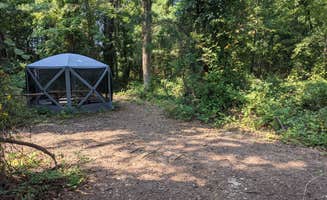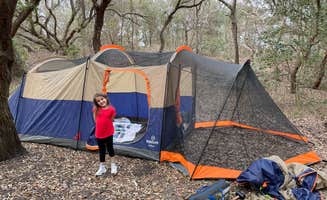Tent camping near Seaford, Virginia offers varied access to both coastal and inland waterways within a 30-mile radius. The region falls within USDA Hardiness Zone 8a, with a camping season that typically runs from March through November, though year-round options exist. Summer temperatures average 85-90°F with high humidity, while spring and fall provide milder camping conditions in the 60-75°F range.
What to do
Kayaking opportunities: Sandy Bottom Nature Park provides accessible water recreation with affordable rentals. According to Susan P., "To kayak here it's the bomb!"
Wildlife viewing: The region's wetland and forest ecosystems support diverse bird populations. Jesse S. notes at False Cape State Park Campground, "Nice isolation, wonderful clean beach, have to hike or bike minimally 4mi from Back Bay NWR to get to the park."
Hiking networks: Multiple trail systems connect camping areas to beaches and inland forests. "We hiked over 30 miles over the weekend," reports one visitor, with routes varying from sandy beach walks to packed gravel paths through maritime forests.
Fishing experiences: Multiple campgrounds offer freshwater and saltwater fishing access. Sam M. reports, "The saltwater fishing in the area was great. My cousin even caught a few baby sharks."
What campers like
Privacy between sites: At Wisteria Beach Hideaway, the separation between camping areas creates a more intimate experience. One camper notes, "Site is very private; I never saw anyone (but the hosts are very easy to communicate with and readily answer any questions)."
Beach proximity: Oceanfront camping options allow tent campers direct access to uncrowded shoreline. "Nothing better than a beach sunset. Plus there are a ton of different types of birds out there if you like wildlife," shares one camper.
Trails accessibility: Multiple parks feature interconnected trail systems leading directly from campsites. According to Gracie B., "Lots of hiking trails to walk & turtles in the lake!! Plus you can rent boats for a cheap price which we will probably go back to do."
Site amenities: Some locations provide unexpected comforts at primitive sites. Kat H. shares, "The provided insect screen kept us well protected in mid-sept. The hosts had extra supplies tucked under the table which is always a nice touch. There was a swinging grill grate on the firepit, which was great for camp pizzas!"
What you should know
Access limitations: The most remote sites require physical effort to reach. Tim R. explains, "From the parking lot to our campsite, it was about 7.5 miles. Some campsites are closer by a couple of miles. We're both in good shape, and on bike we made the trek in less than an hour."
Wildlife encounters: Insect activity varies by season with higher populations during summer months. Julie A. advises at Sandy Bottom Nature Park, "Snakes can get pretty bad along the right trail starting from the parking lot in Back Bay down near the fishing pond so watch your step. We usually stomp our feet and the vibrations make them move off of the trail."
Water planning: Hydration requirements increase during hiking access to remote sites. Jesse S. recommends, "Bring plenty of water for hike in during summer, hardly any shade hiking in."
Seasonal variations: Different times of year present unique challenges. "We came in mid-June and the weather was gorgeous - 80s during the day and 60s at night. There were some biting flies and mosquitos but nothing a little bug spray couldn't take care of," reports one camper.
Tips for camping with families
Beach camping with kids: Some locations accommodate families despite remote locations. Stephanie J. shares, "When we went we brought our 2 and 4 year old children. My husband and I each hooked a trailer to our bikes, and I towed the kids and he towed our gear. The kids loved riding through Back Bay."
Dog-friendly options: Many campgrounds welcome pets with varying restrictions. Brandon W. notes about Sandy Bottom Nature Park, "It is extremely dog friendly with a fenced in dog park as well."
Campsite selection: Family groups should consider proximity to facilities. According to N I., "The individual campsites are FCFS and you must park and hike in. It is a short hike along the lake and placed a short distance from the trail so hikers will not be hiking through the sites."
Nature center programming: Educational opportunities enhance family camping experiences. "There is an amazing nature center that overlooks Sandy Bottom Lake. Hiking, and biking trails, fishing, boating with boat rentals or bring your own, birding and wildlife viewing," explains one visitor.
Tips from RVers
Limited RV access: Most primitive camping areas near Seaford restrict larger vehicles. At Carter's Cove Campground, N I. reports, "More of a long term stay but there are a few spots for RVs. Laundry, trash, restrooms, picnic table, fire pit (day use only). Mature trees and over all space is very large. Sites are level with some spacing."
Utility connections: Electric and water connections vary significantly between locations. Tim R. notes, "We brought a collapsible 5 gallon jug that I had to ride back to the visitors center (about 2 miles from our campsite) to fill up."




